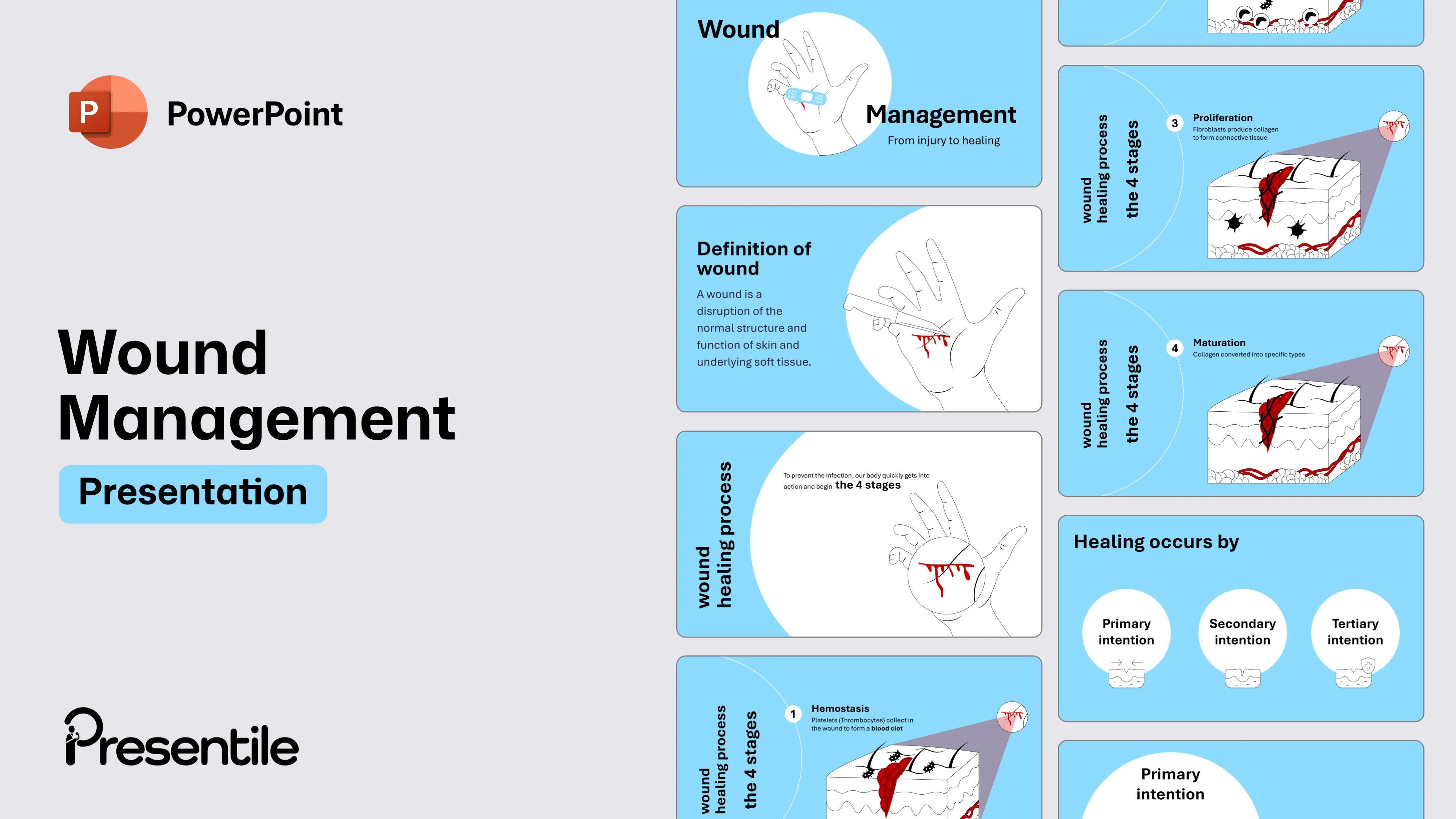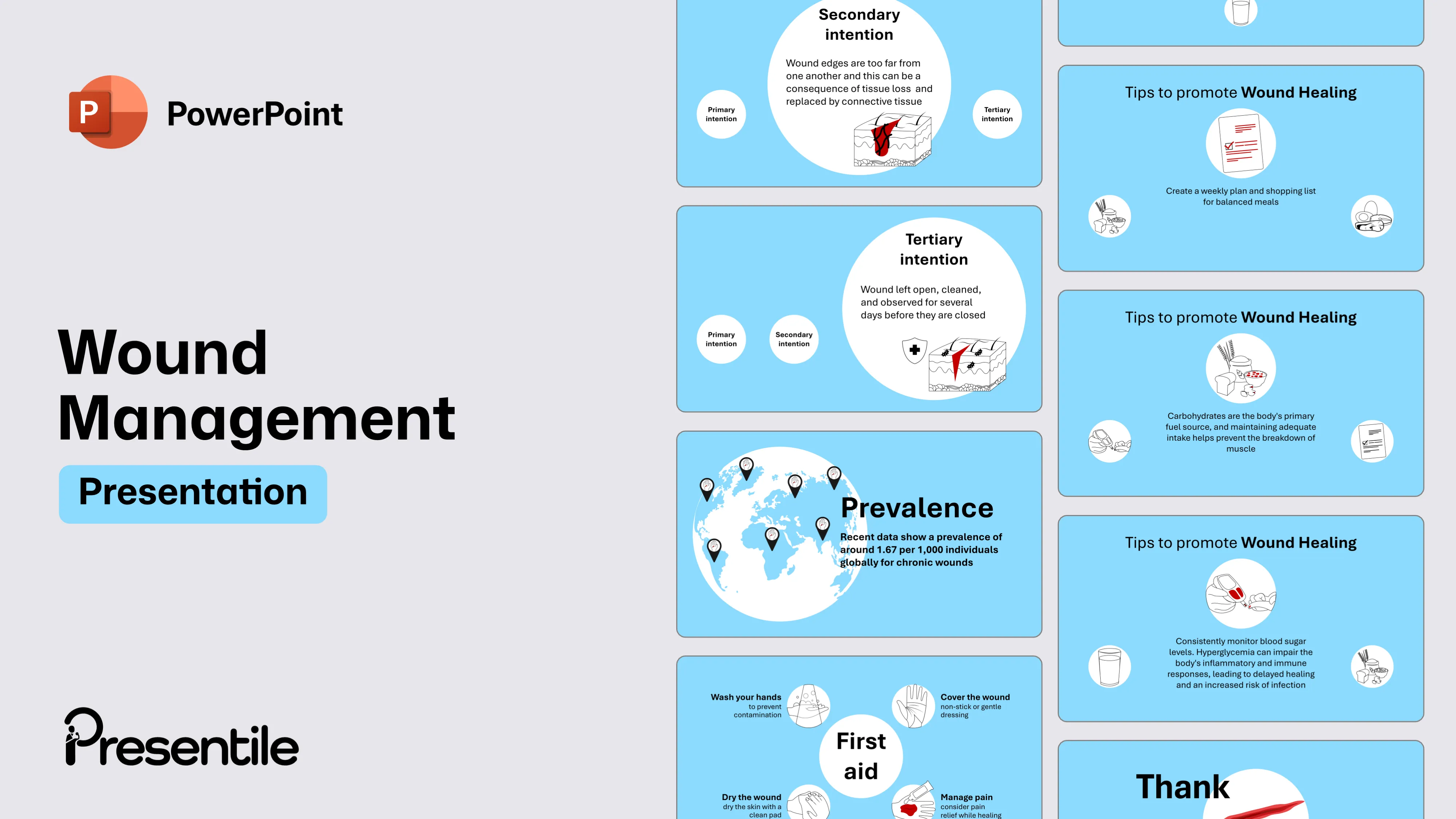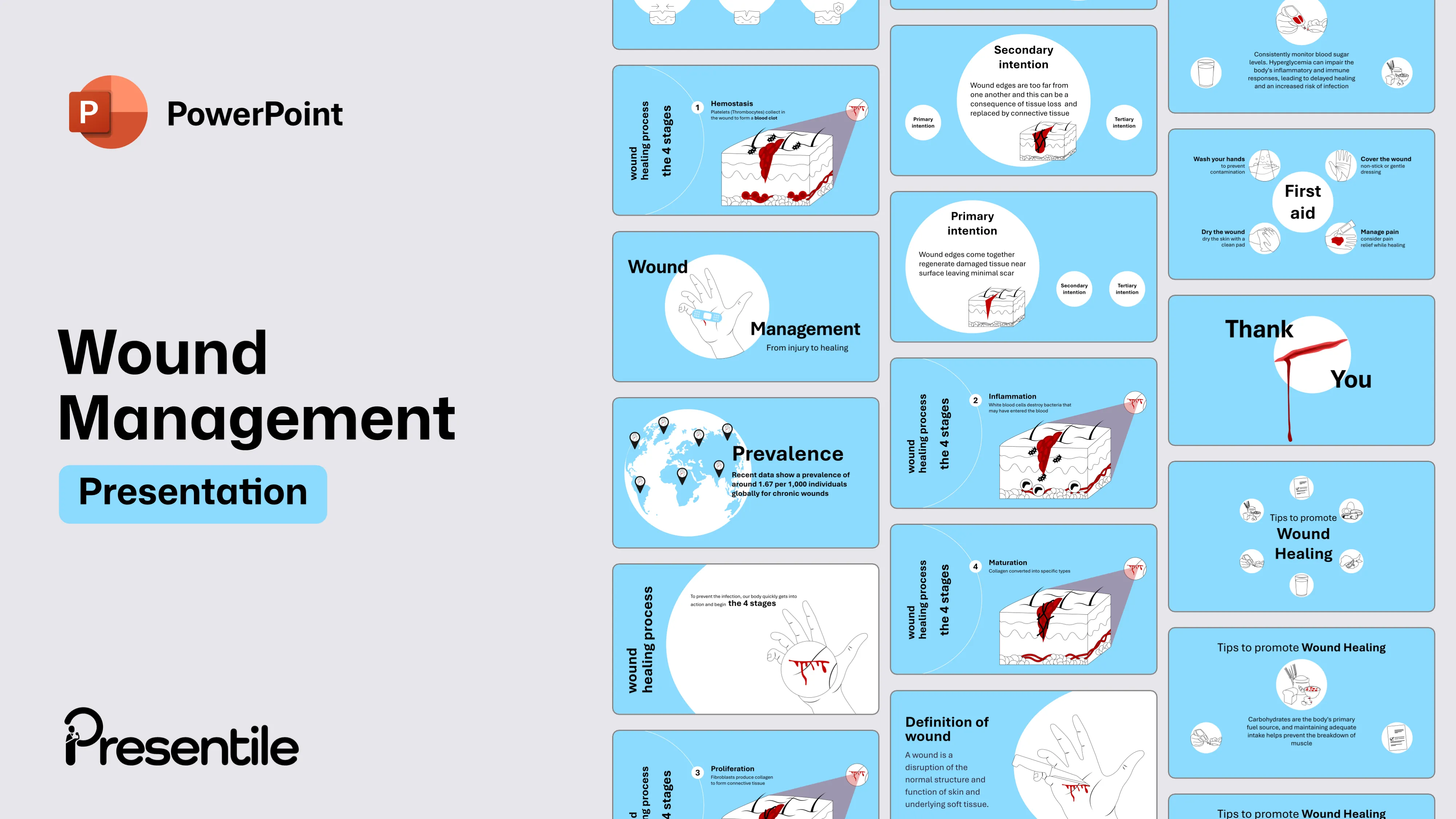
Content of
Wound Management Presentation
Slide 1: Wound Management – From Injury to Healing
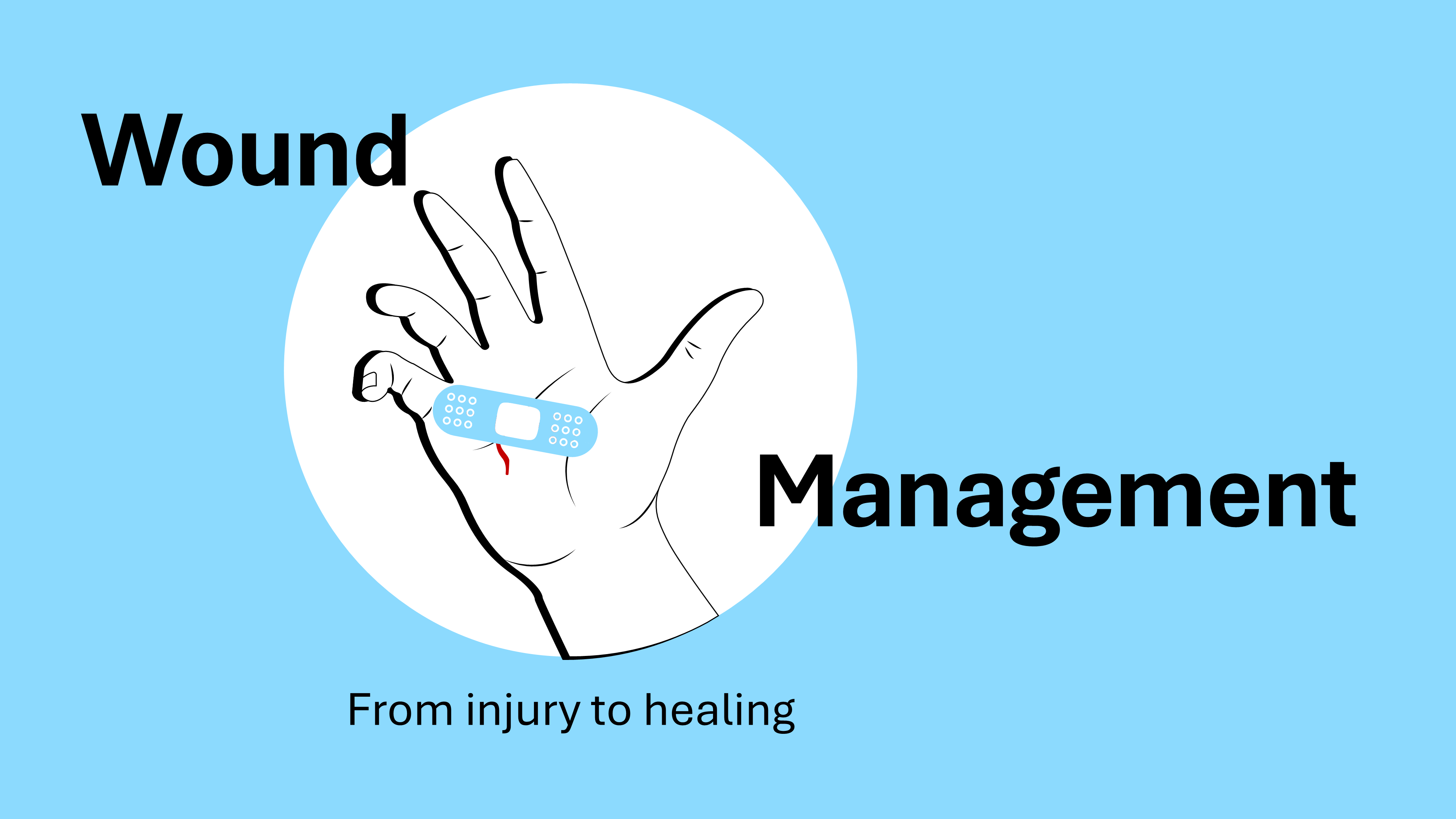
- This title slide instantly grabs attention with its clear, minimalist design. A simple, compelling visual—a hand with a small, bandaged wound—is centered to introduce the topic of Wound Management.
- The subtitle, “From injury to healing,” clearly defines the scope of the presentation.
- This slide uses a clean, professional aesthetic to set the tone, ensuring your audience knows they are about to engage with a comprehensive, well-structured medical presentation. Its simplicity makes it easy to read, perfect for immediately engaging a professional audience.
Slide 2: What is a Wound?

- This slide provides a clear, concise definition of a wound, establishing a foundational understanding for the rest of the presentation.
- The text boldly defines a wound as a “disruption of the normal structure and function of skin and underlying soft tissue.” The accompanying visual of a hand with a knife is a powerful, albeit stark, illustration that reinforces the concept.
- This combination of straightforward text and an impactful image ensures that the audience immediately grasps the core medical definition.
Slide 3: The Four Stages of Wound Healing
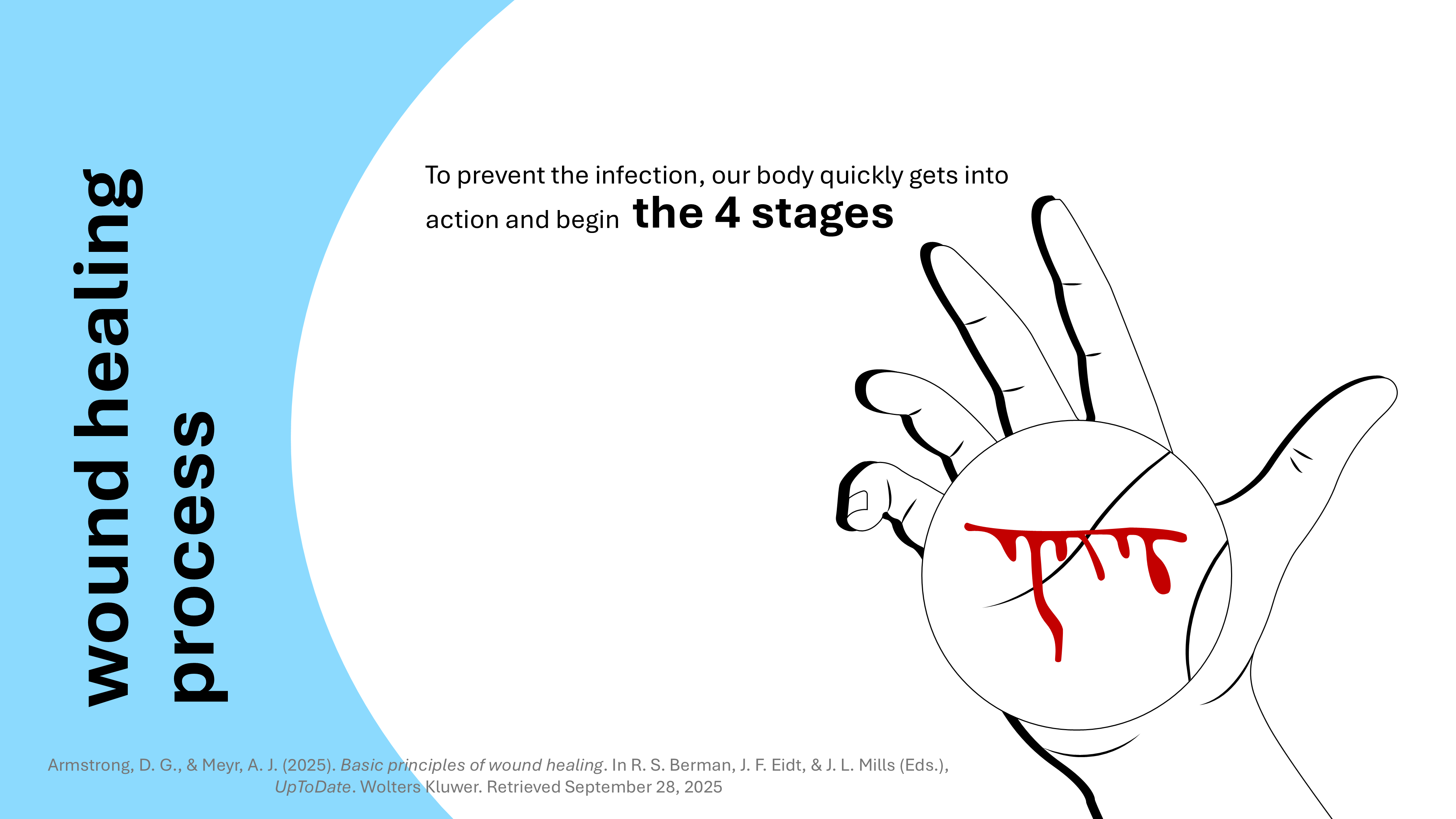
- This slide introduces the wound healing process as a dynamic response to injury.
- It highlights that the body immediately begins a four-stage process to prevent infection and restore tissue integrity.
- The clean, simple design and bolded text (“the 4 stages”) emphasize the key takeaway, preparing the audience for a detailed breakdown of each phase.
- The visual of a hand with a wound reinforces the central theme, connecting the abstract concept to a clear, relatable image.
Slide 4: Stage 1 – Hemostasis
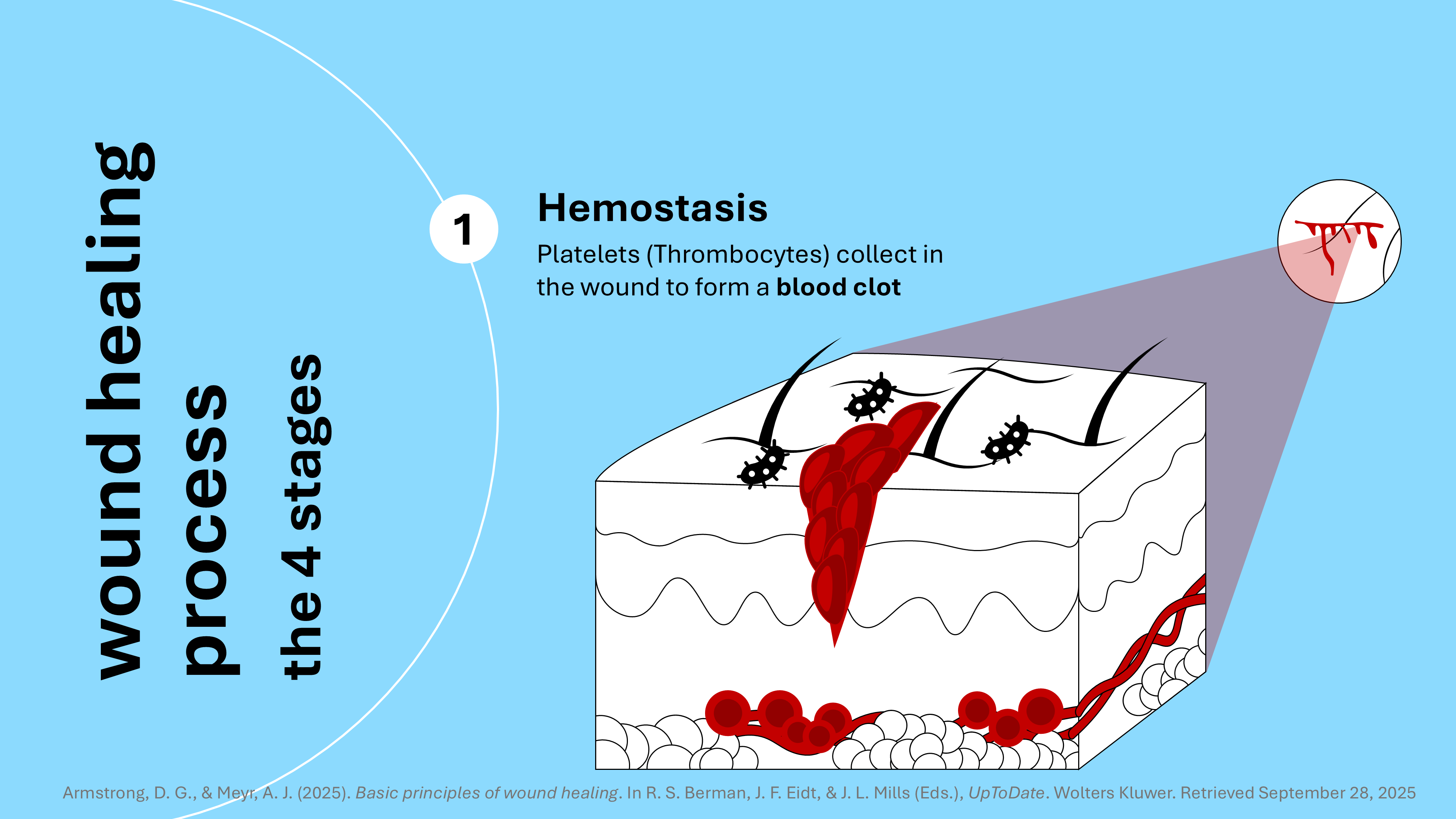
- This slide focuses on the first critical stage of wound healing: Hemostasis.
- It clearly explains how platelets (thrombocytes) rapidly gather at the wound site to form a blood clot, effectively stopping the bleeding.
- The detailed, layered diagram visually represents this process, showing the platelets aggregating within the disrupted tissue.
- This slide is key for explaining the body’s immediate, life-saving response to injury in a clear and scientifically accurate manner.
Slide 5: Stage 2 – Inflammation
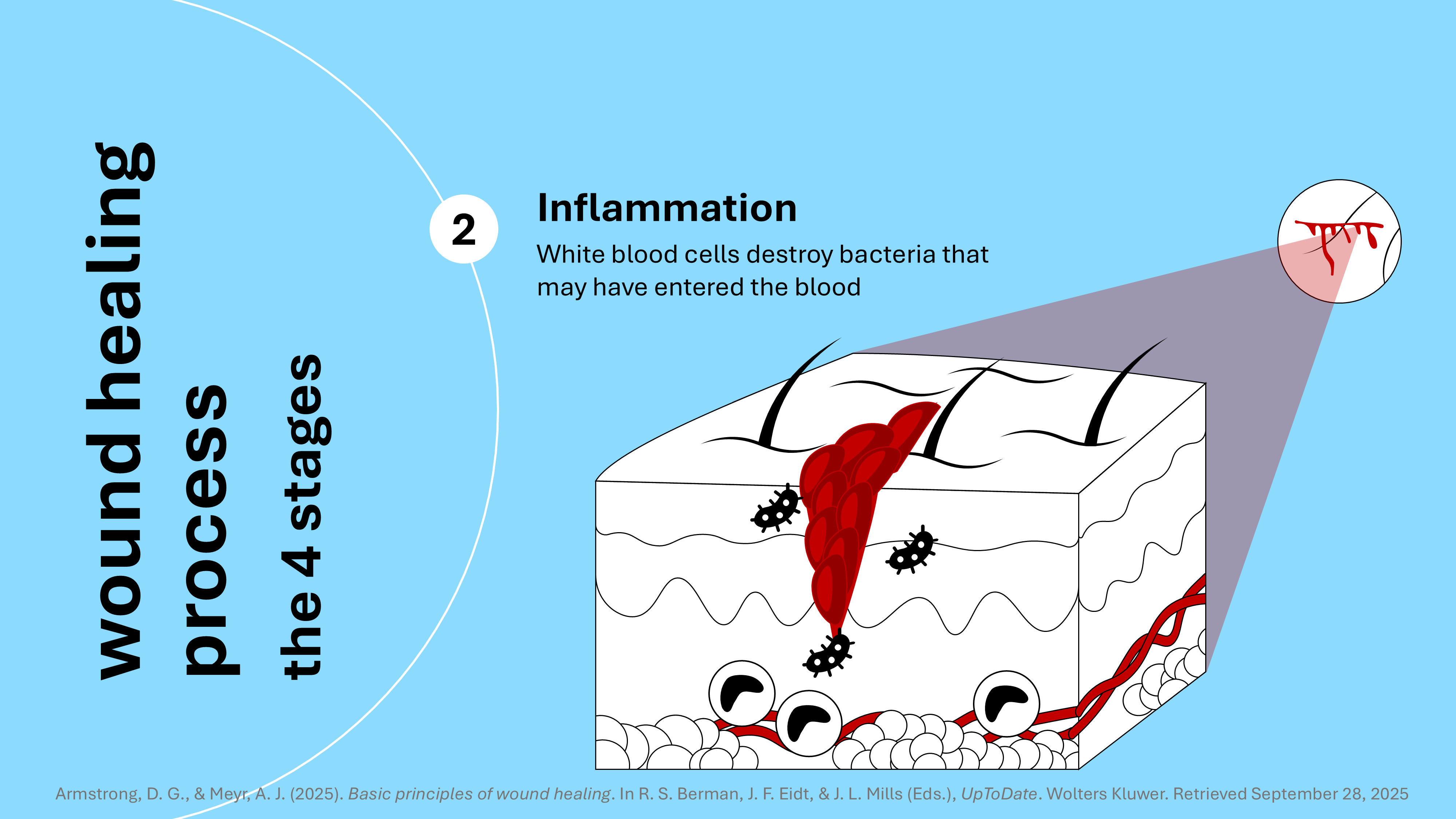
- This slide covers the second stage of wound healing: Inflammation.
- It explains how white blood cells rush to the site of the wound to destroy any bacteria that may have entered the tissue.
- The detailed diagram illustrates this process, showing the white blood cells migrating toward the wound to combat potential infection.
- This slide effectively communicates the body’s critical immune response and sets the stage for the next phases of tissue repair.
Slide 6: Stage 3 – Proliferation
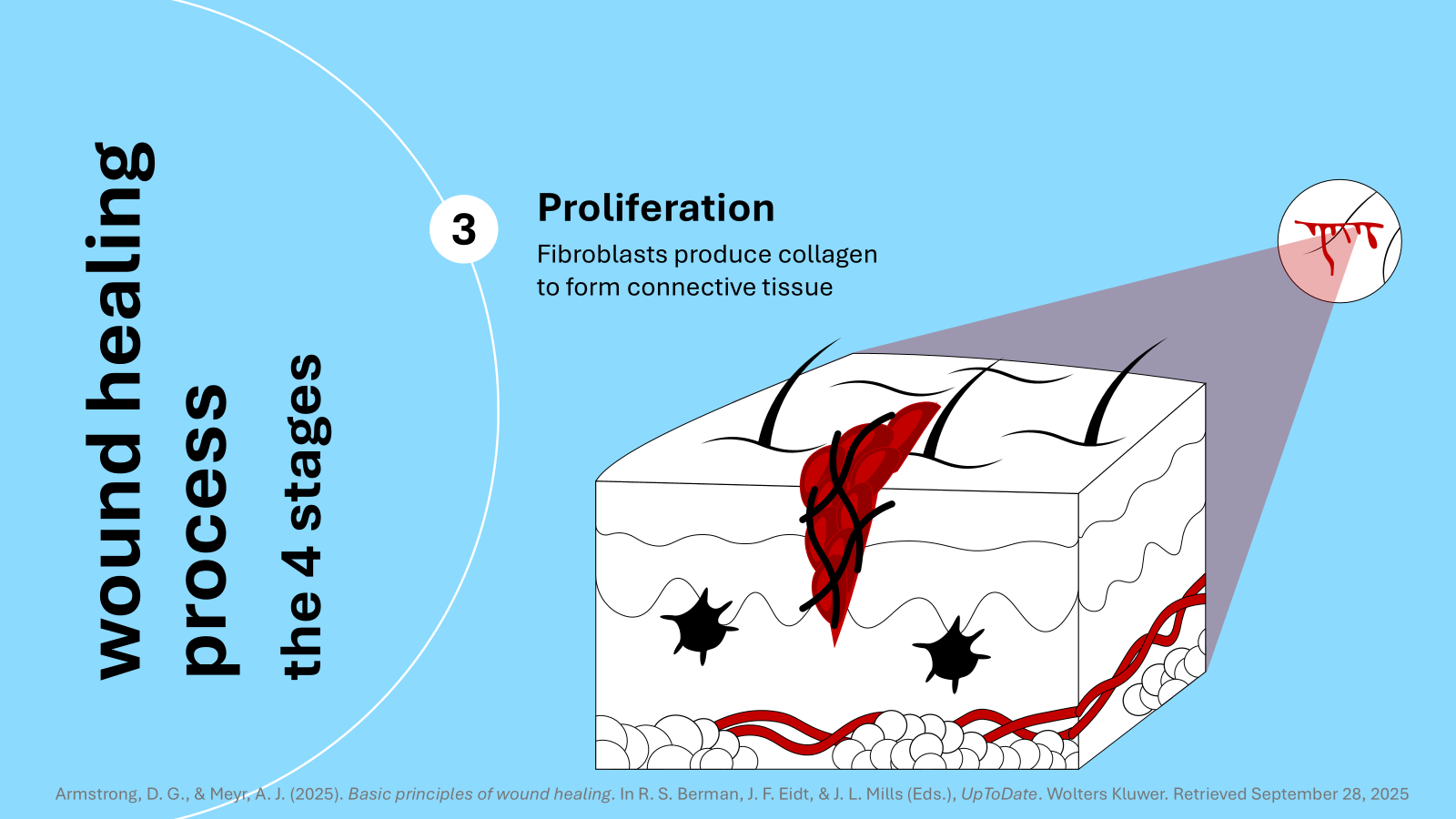
- This slide details the third stage of wound healing, Proliferation, a crucial phase for rebuilding damaged tissue.
- It highlights the role of fibroblasts, specialized cells that produce collagen to form new connective tissue.
- The visual reinforces this concept by showing red fibers beginning to bridge the gap in the wound, representing the formation of new tissue.
- This slide clearly explains how the body begins to physically repair the injury, leading into the final stage of healing.
Slide 7: Stage 4 – Maturation
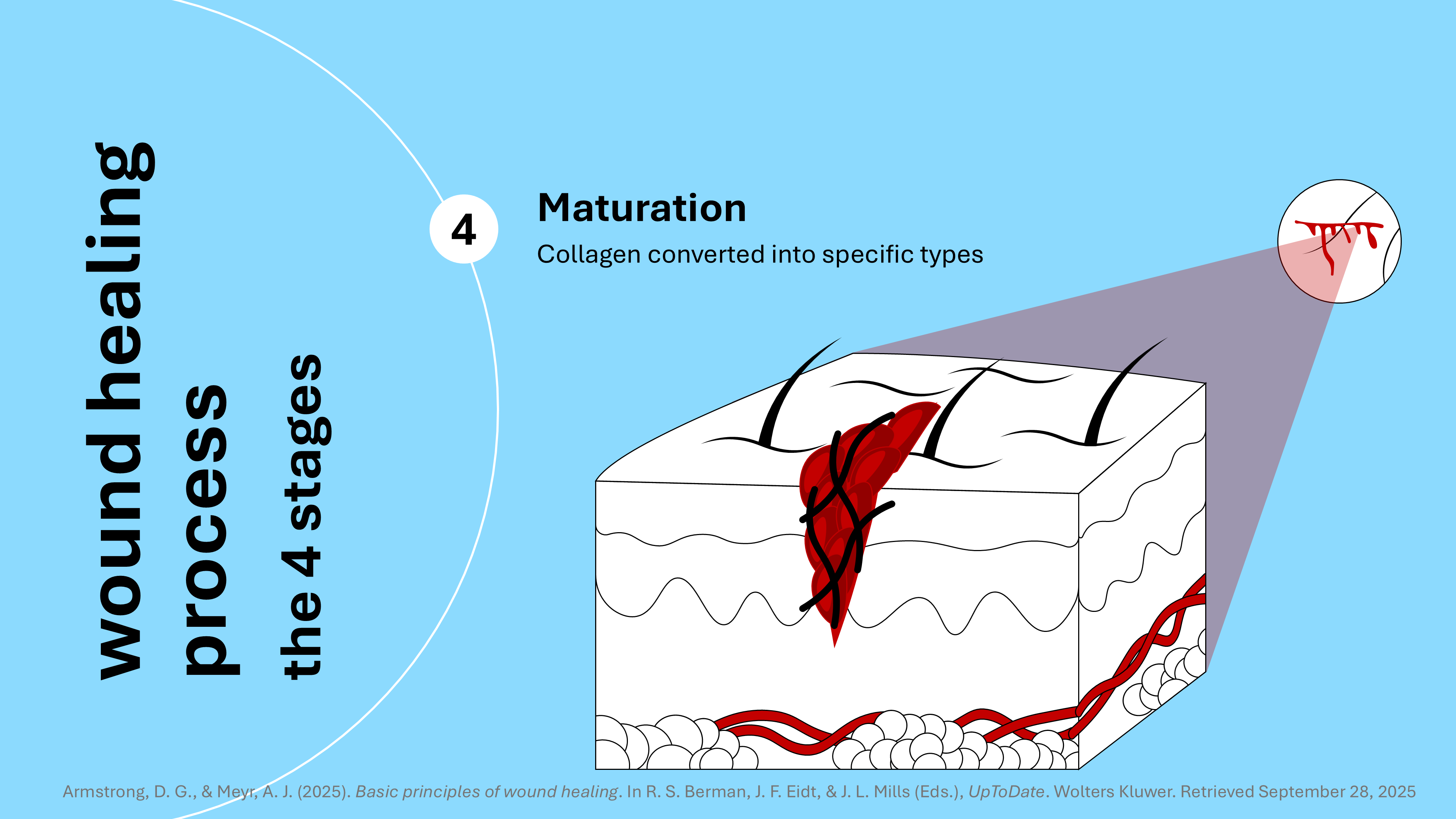
- This slide describes the final stage of wound healing, Maturation, also known as remodeling.
- It explains how the newly formed collagen is converted into more specific, organized types.
- This process strengthens the tissue, improving its tensile strength and returning it to a state closer to its original form.
- The visual on the slide illustrates this refinement, showing the collagen fibers becoming more structured.
- This final step completes the presentation’s comprehensive overview of the body’s natural healing process.
Slide 8: Healing Intentions – Primary, Secondary, and Tertiary

- This slide introduces the three main ways a wound can heal: by Primary, Secondary, and Tertiary Intention.
- It visually separates each type into its own circle, with a simple, illustrative icon below.
- This design effectively breaks down complex concepts into digestible parts, making it easy for the audience to understand the different pathways of wound closure.
- The slide serves as a clear, high-level overview before delving into the specifics of each healing type.
Slide 9: Primary Intention Healing
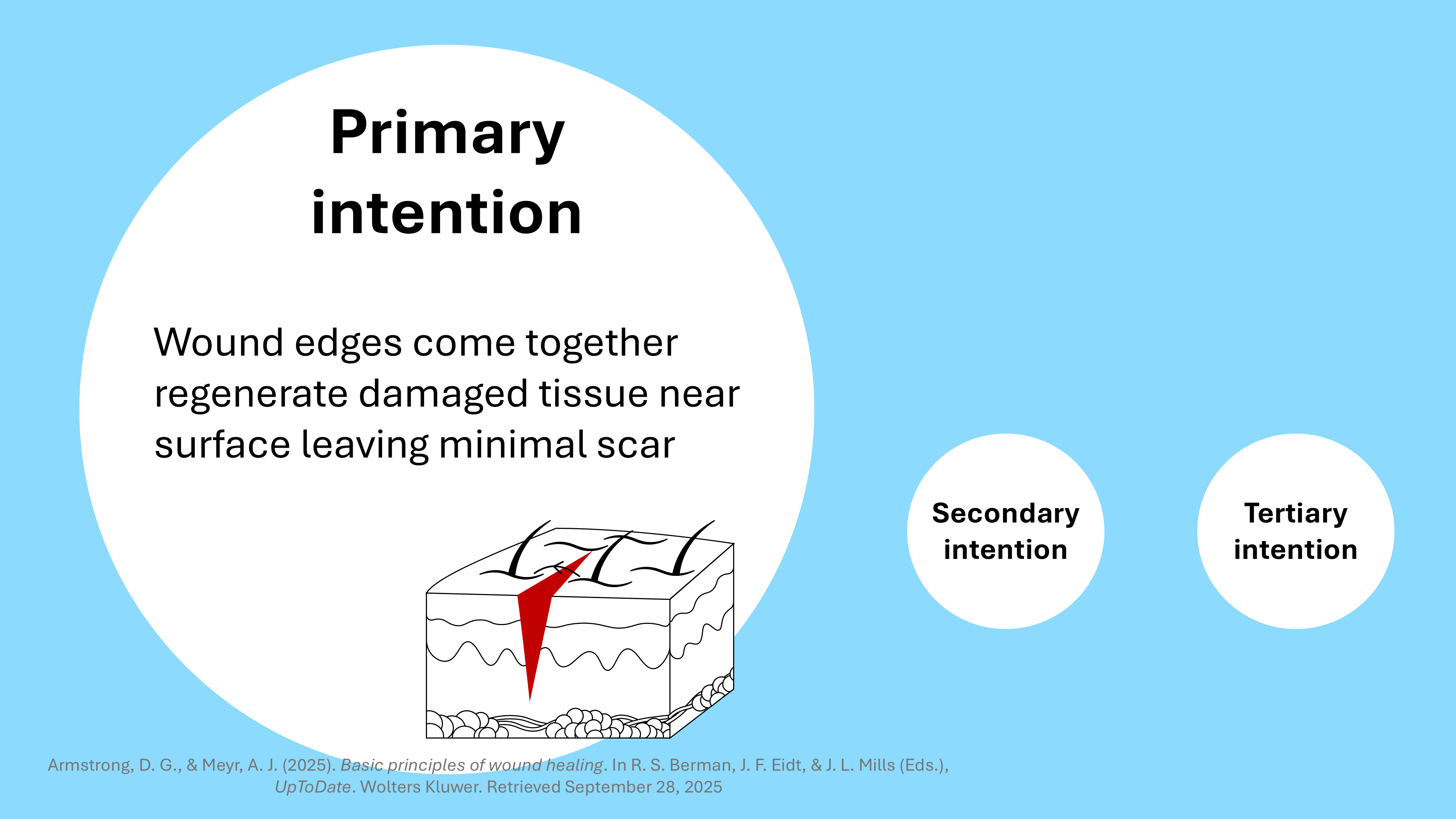
- This slide details the process of healing by Primary Intention.
- It explains that this occurs when the edges of a wound are brought together, allowing the damaged tissue to regenerate with minimal loss of skin.
- The process results in a minimal scar, which is the key takeaway for this method of healing.
- The accompanying diagram clearly illustrates the wound edges being approximated, providing a visual example of this clean healing process.
Slide 10: Secondary Intention Healing
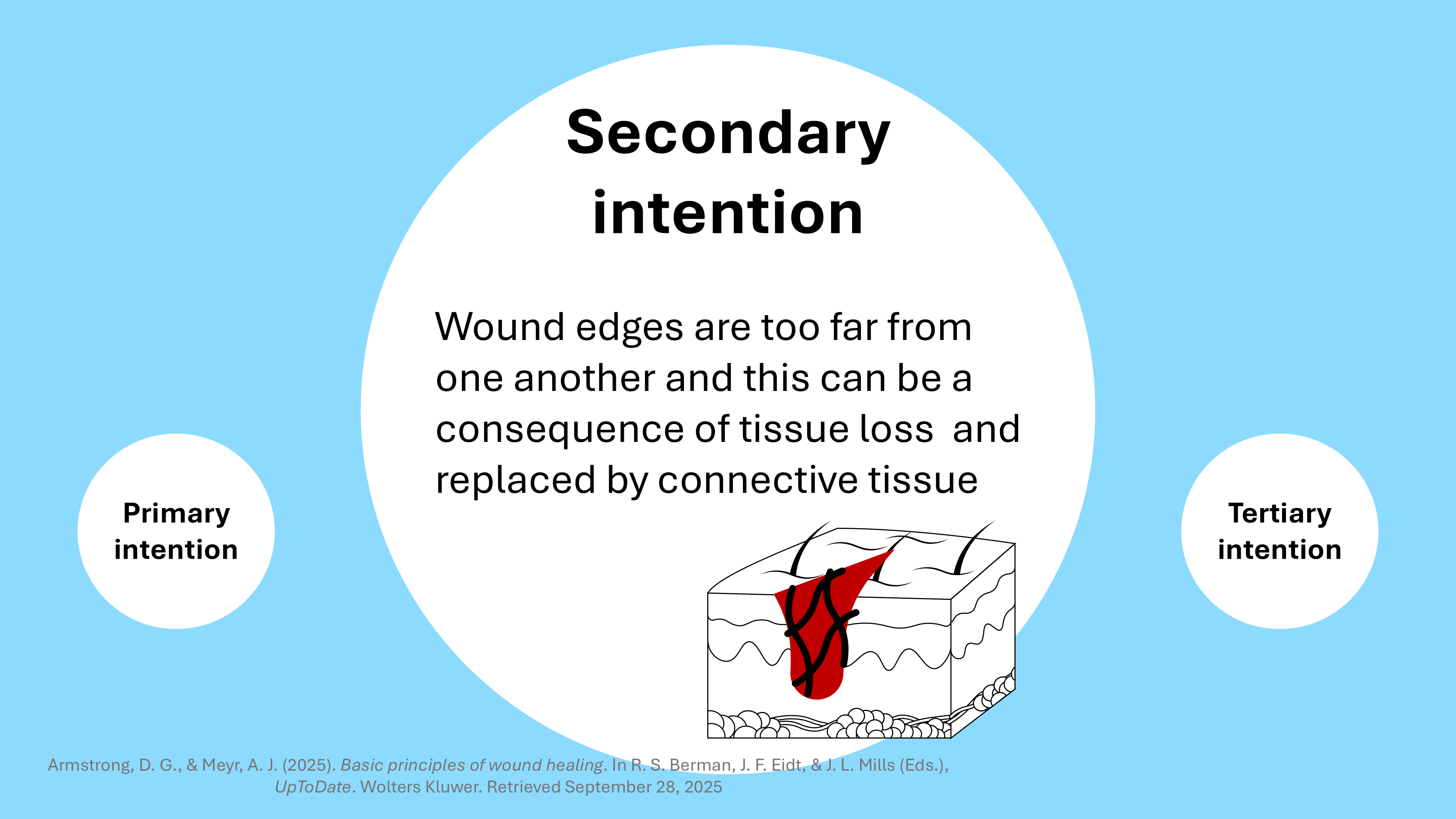
- This slide explains Secondary Intention healing, which occurs when a wound’s edges are too far apart to be brought together.
- This is a common consequence of significant tissue loss.
- The healing process is more complex, relying on the wound to be filled with connective tissue and then contracting to close the gap.
- The visual clearly illustrates this process, showing the wide separation of the wound edges and the red connective tissue forming within the open space.
- This slide effectively contrasts with primary intention healing and highlights the more extensive repair required.
Slide 11: Tertiary Intention Healing
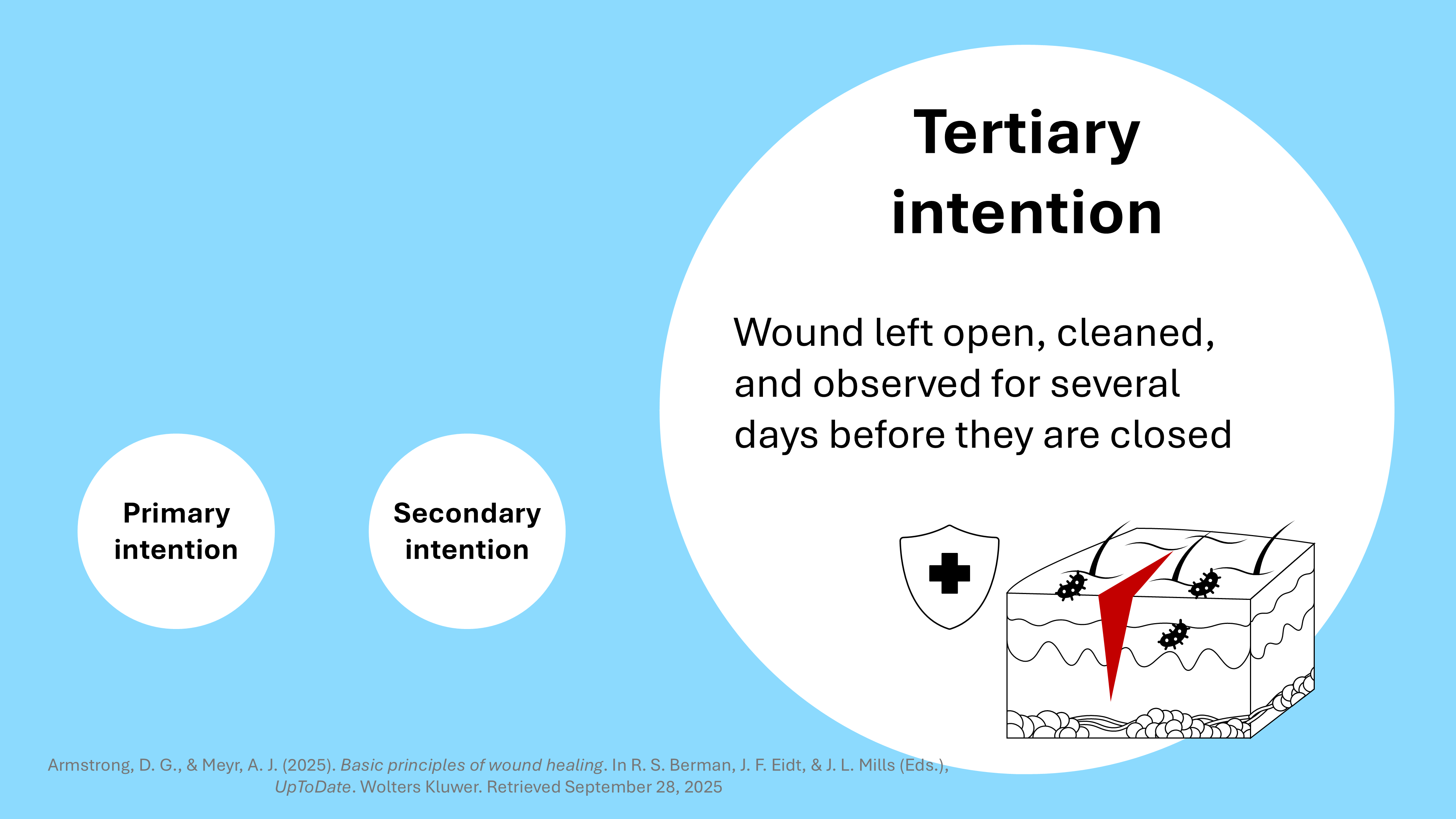
- This slide describes the process of Tertiary Intention healing, also known as delayed primary closure.
- It explains that this method is used when a wound is left open for several days after injury.
- During this time, the wound is cleaned and observed to reduce the risk of infection before it’s surgically closed.
- The accompanying diagram shows the wound open with a protective shield icon, symbolizing the careful management and observation required for this healing process.
- This slide effectively highlights a crucial clinical approach to managing contaminated or high-risk wounds.
Slide 12: Global Prevalence of Chronic Wounds
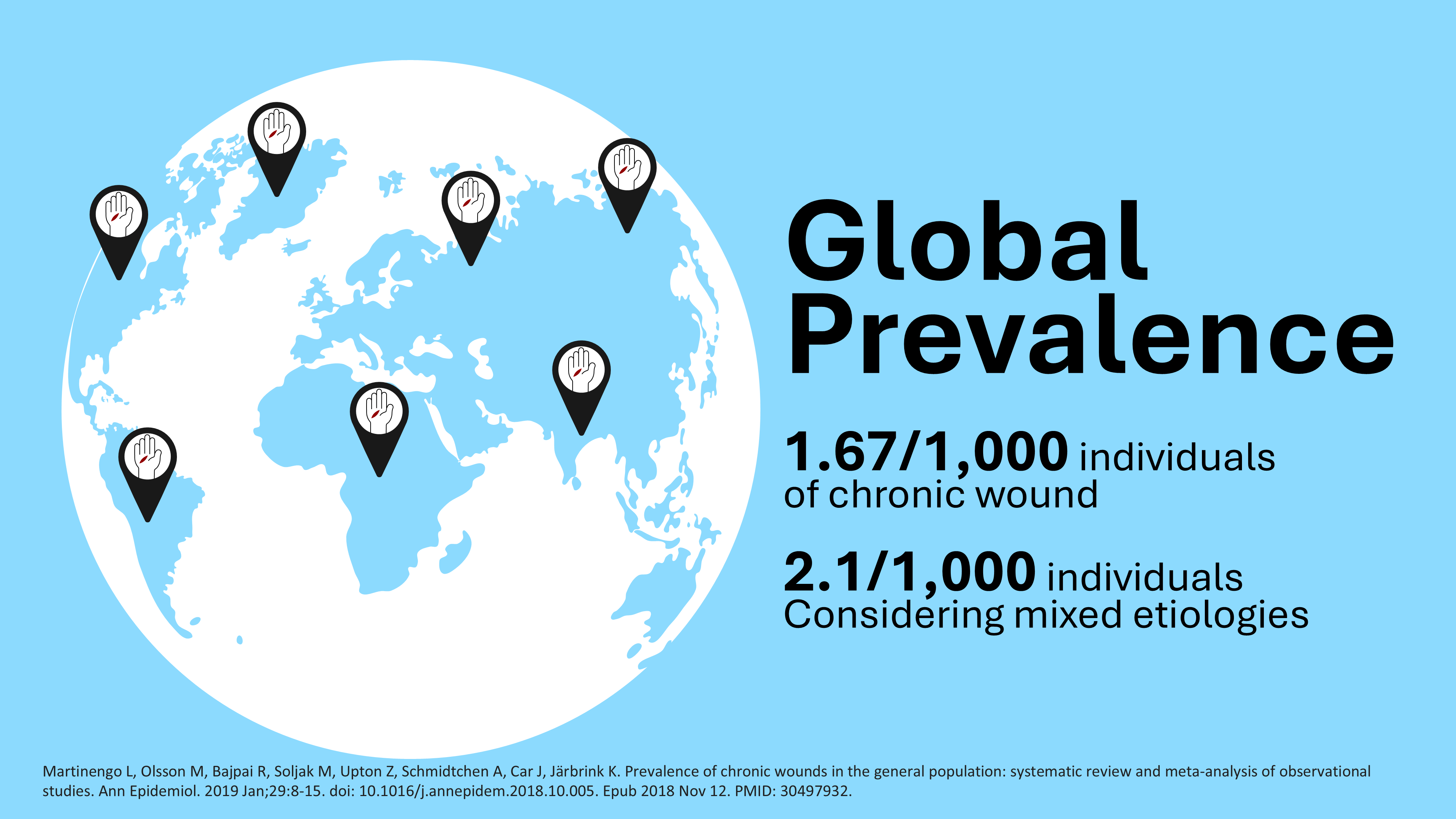
- This slide shifts the focus to the prevalence of chronic wounds on a global scale.
- It presents key data, stating that recent studies show a prevalence of around 1.67 per 1,000 individuals globally.
- The visual of a world map with location pins, each marked with a bandaged hand, powerfully illustrates the widespread nature of this condition.
- This slide effectively highlights the significant public health impact of chronic wounds and provides crucial context for the clinical discussions that follow.
Slide 13: Wound First Aid Essentials

- This slide provides a clear, circular overview of essential first aid steps for wound management.
- Each step is presented in a separate bubble with a simple, illustrative icon to ensure clarity and easy recall.
- The steps include: Washing hands to prevent contamination, drying the wound with a clean pad, covering the wound with a non-stick dressing, and managing pain with appropriate relief.
- This visually intuitive layout makes complex information accessible and actionable for both medical professionals and the general public.
Slide 14: Promoting Optimal Wound Healing
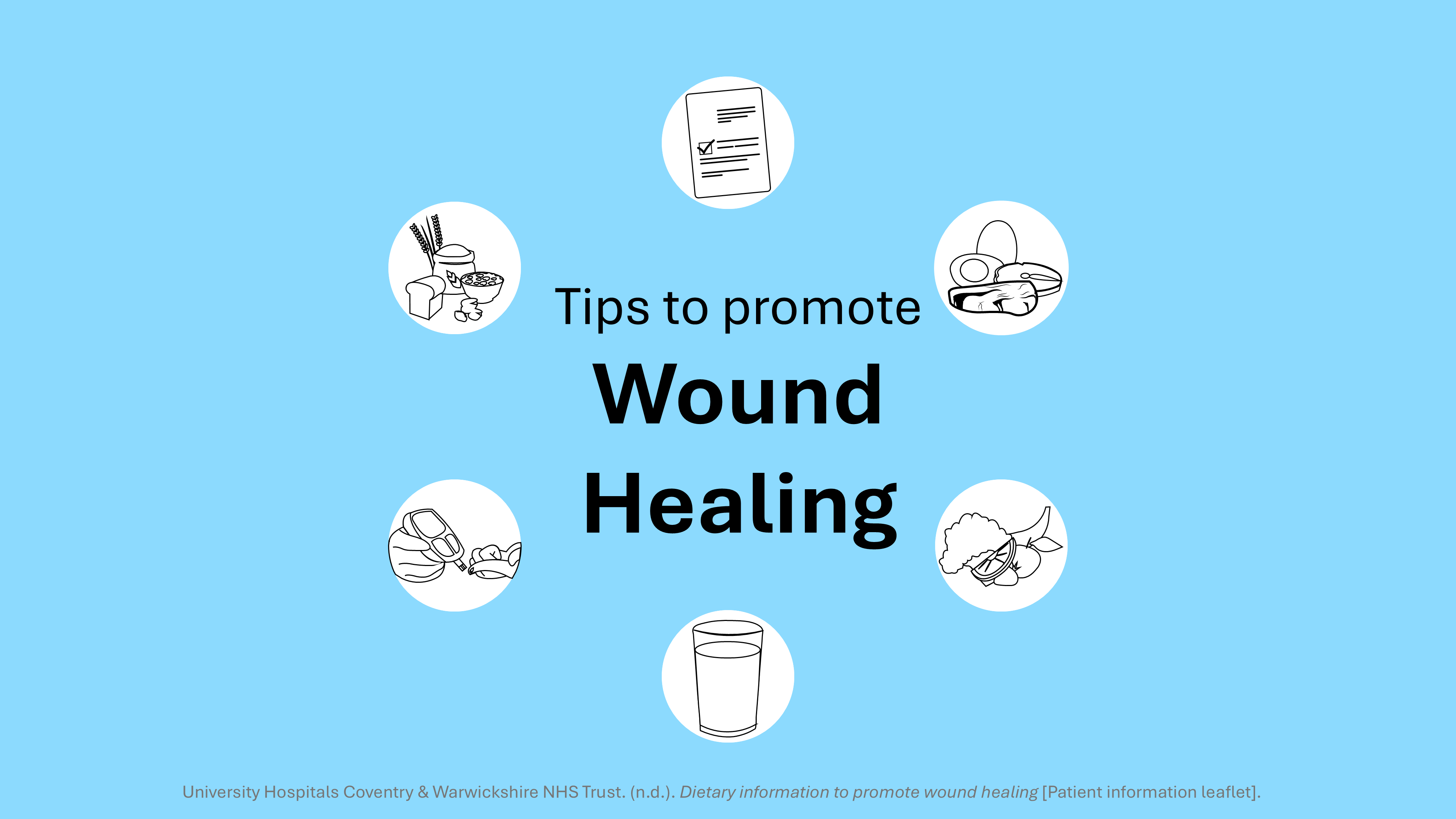
- This slide offers a comprehensive overview of key tips to promote wound healing.
- The design uses a central heading surrounded by five circular icons, each representing a crucial factor.
- From nutritional advice (protein and vitamins) to hydration and following medical instructions, the slide visually reinforces the holistic approach to effective wound management.
- This layout makes the information easy to scan and digest, providing practical guidance for patients and professionals alike.
Slide 15: Tip – Create a Balanced Meal Plan
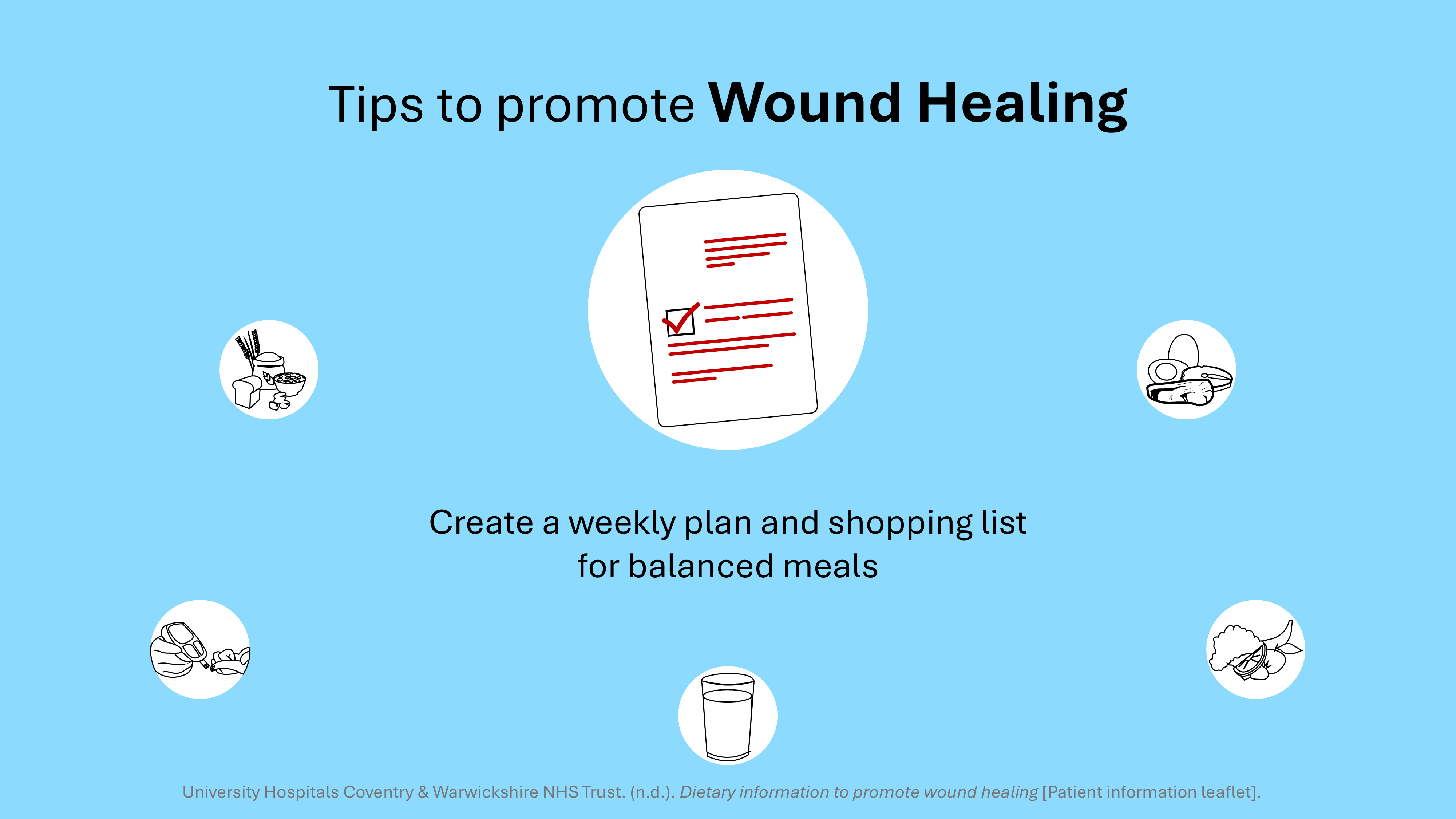
- This slide focuses on the crucial role of nutrition in promoting wound healing.
- It specifically advises creating a weekly meal plan and shopping list to ensure a diet with balanced meals.
- The visual of a checklist emphasizes the importance of a structured approach to nutrition, reinforcing that proper dietary intake is not a passive act but an active part of the healing process.
- This slide effectively highlights how simple planning can significantly support the body’s repair mechanisms.
Slide 16: The Role of Carbohydrates in Wound Healing
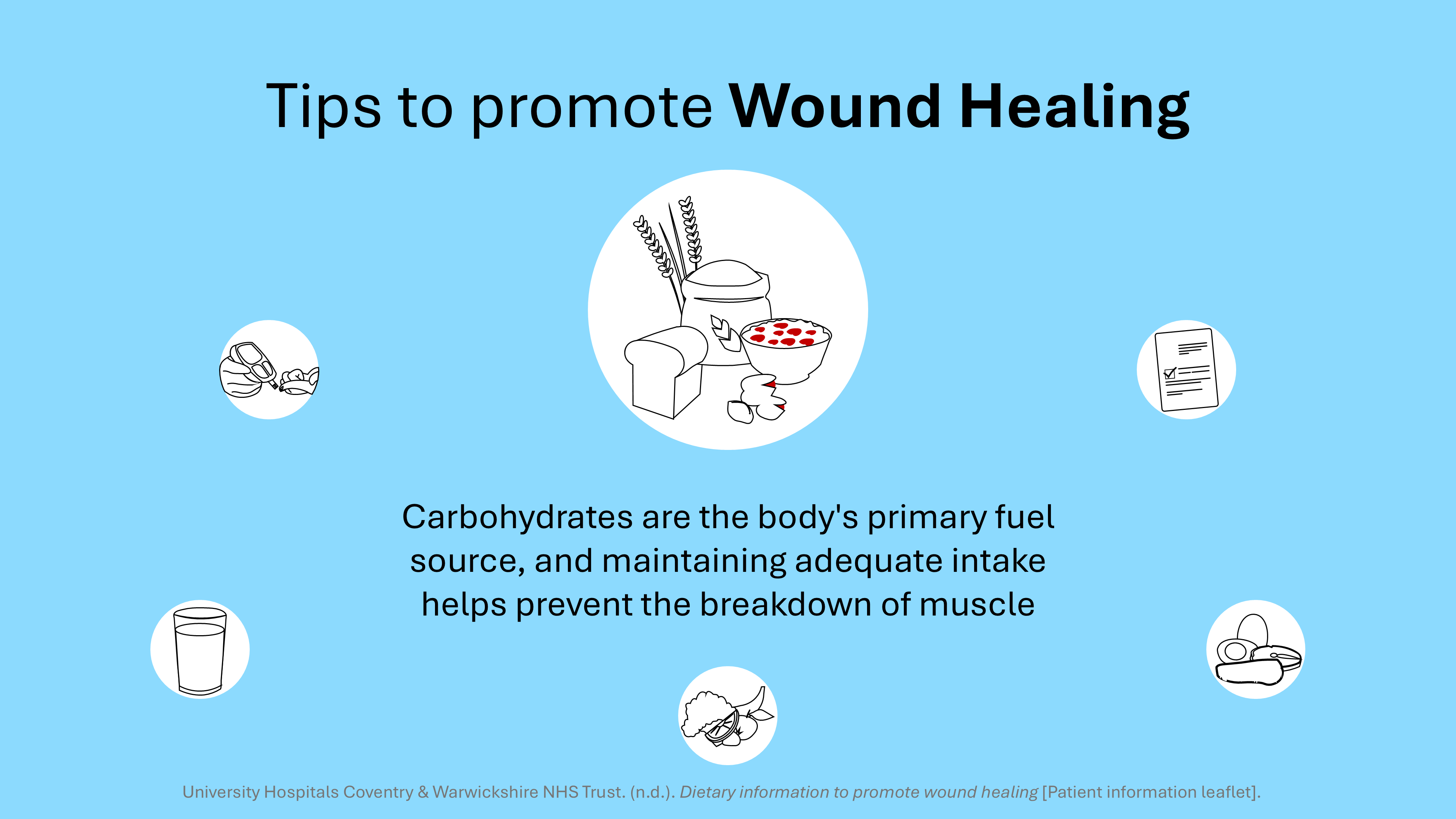
- This slide emphasizes the importance of carbohydrates in the healing process.
- It explains that carbohydrates are the body’s primary fuel source, and a consistent intake helps prevent the body from breaking down muscle tissue for energy.
- The visual of a bowl of grains, a loaf of bread, and other carbohydrate-rich foods reinforces this key message, highlighting how proper nutrition provides the necessary fuel for cellular repair and regeneration.
- This slide effectively connects dietary choices directly to the physiological mechanisms of wound healing.
Slide 17: The Impact of Blood Sugar on Wound Healing
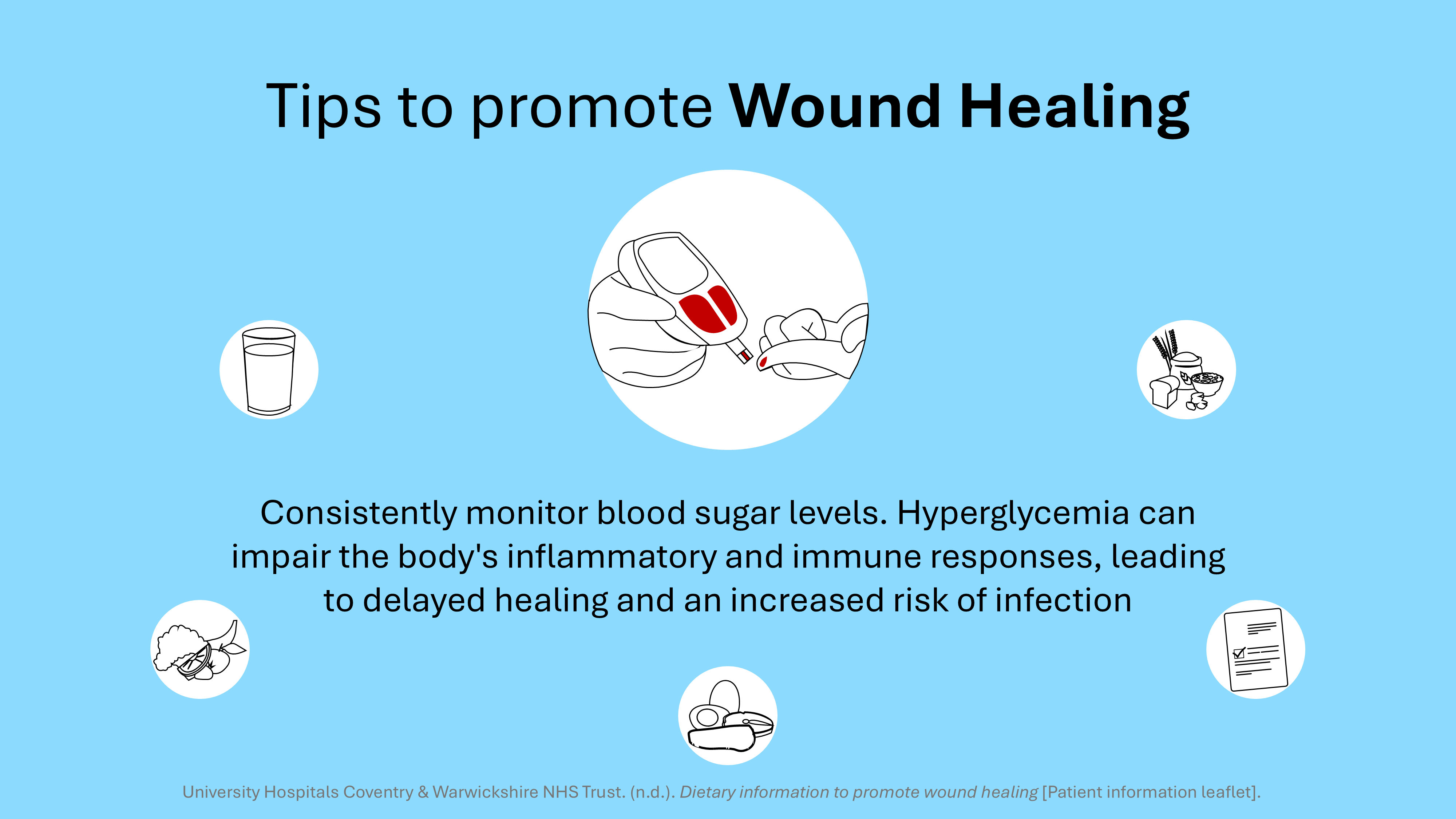
- This slide emphasizes the critical importance of consistently monitoring blood sugar levels to support effective wound healing.
- It explains that hyperglycemia, or high blood sugar, can significantly impair the body’s inflammatory and immune responses.
- This impairment can lead to delayed healing and an increased risk of infection, making blood sugar control a vital part of wound management.
- The visual of a glucose monitor and a drop of blood clearly illustrates this essential practice.
Slide 18: Hydration and Wound Healing
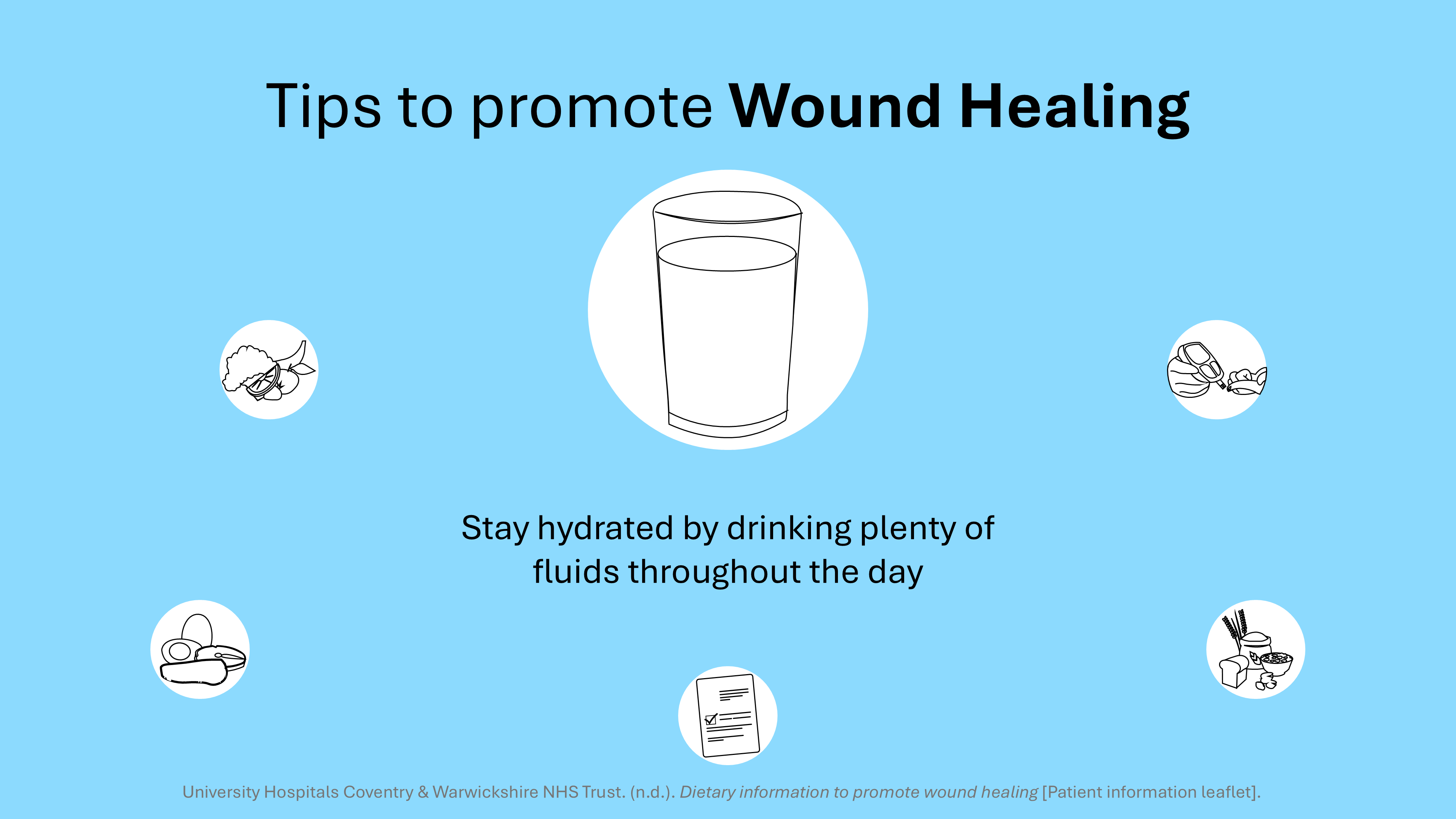
- This slide highlights the fundamental importance of hydration for effective wound healing.
- It advises staying well-hydrated by drinking plenty of fluids throughout the day.
- The visual of a simple glass of water reinforces this message, emphasizing that proper hydration is a straightforward but essential component of supporting the body’s repair processes.
- This slide serves as a clear reminder of a critical yet often overlooked aspect of patient care and recovery.
Slide 19: The Importance of Vitamin C in Wound Healing
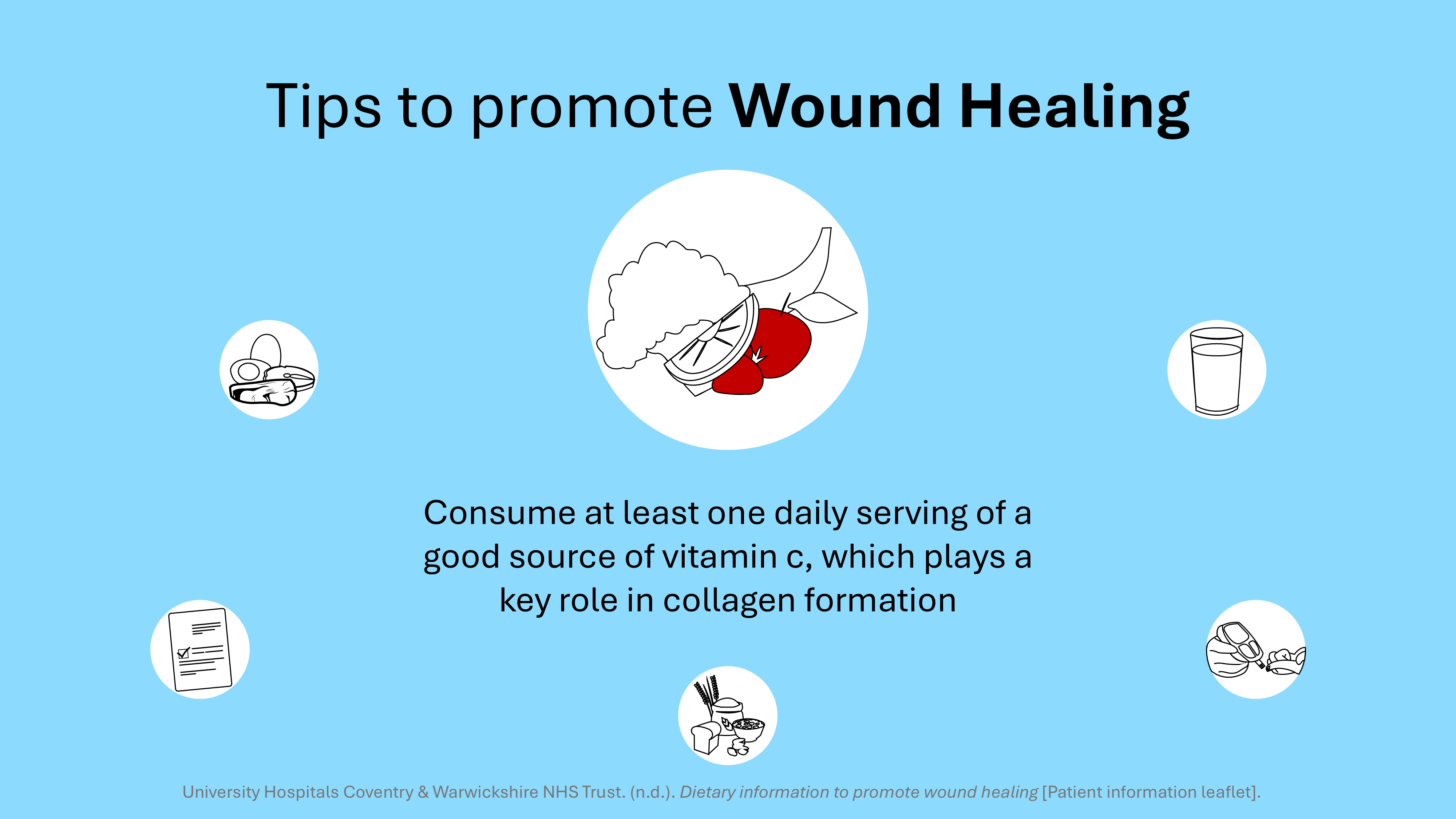
- This slide highlights the crucial role of Vitamin C in wound healing.
- It advises consuming at least one daily serving of a good source of this vitamin.
- The text explains that Vitamin C plays a key role in collagen formation, the building block of new tissue.
- The visual displays common sources of Vitamin C, such as oranges, broccoli, and apples, reinforcing the message that dietary choices directly impact the body’s ability to repair itself.
Slide 20: The Power of Protein in Wound Healing
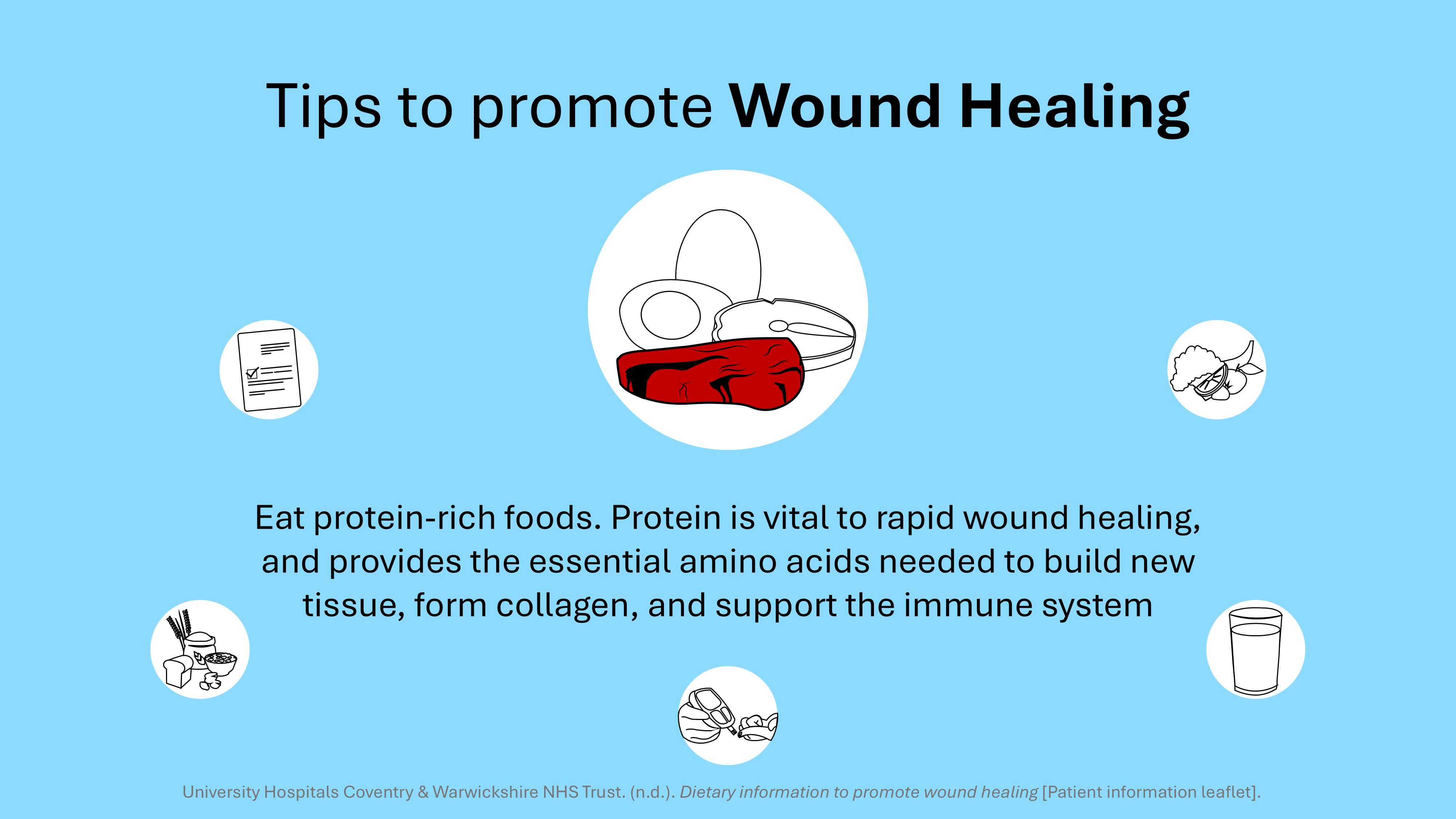
- This slide explains the essential role of protein in promoting rapid wound healing.
- It highlights that protein is a vital nutrient, providing the amino acids necessary to build new tissue and form collagen.
- The text also mentions its crucial function in supporting the immune system.
- The visual of protein-rich foods like meat, eggs, and dairy emphasizes the importance of incorporating these into one’s diet to fuel the body’s repair processes effectively.
Slide 21: Thank You
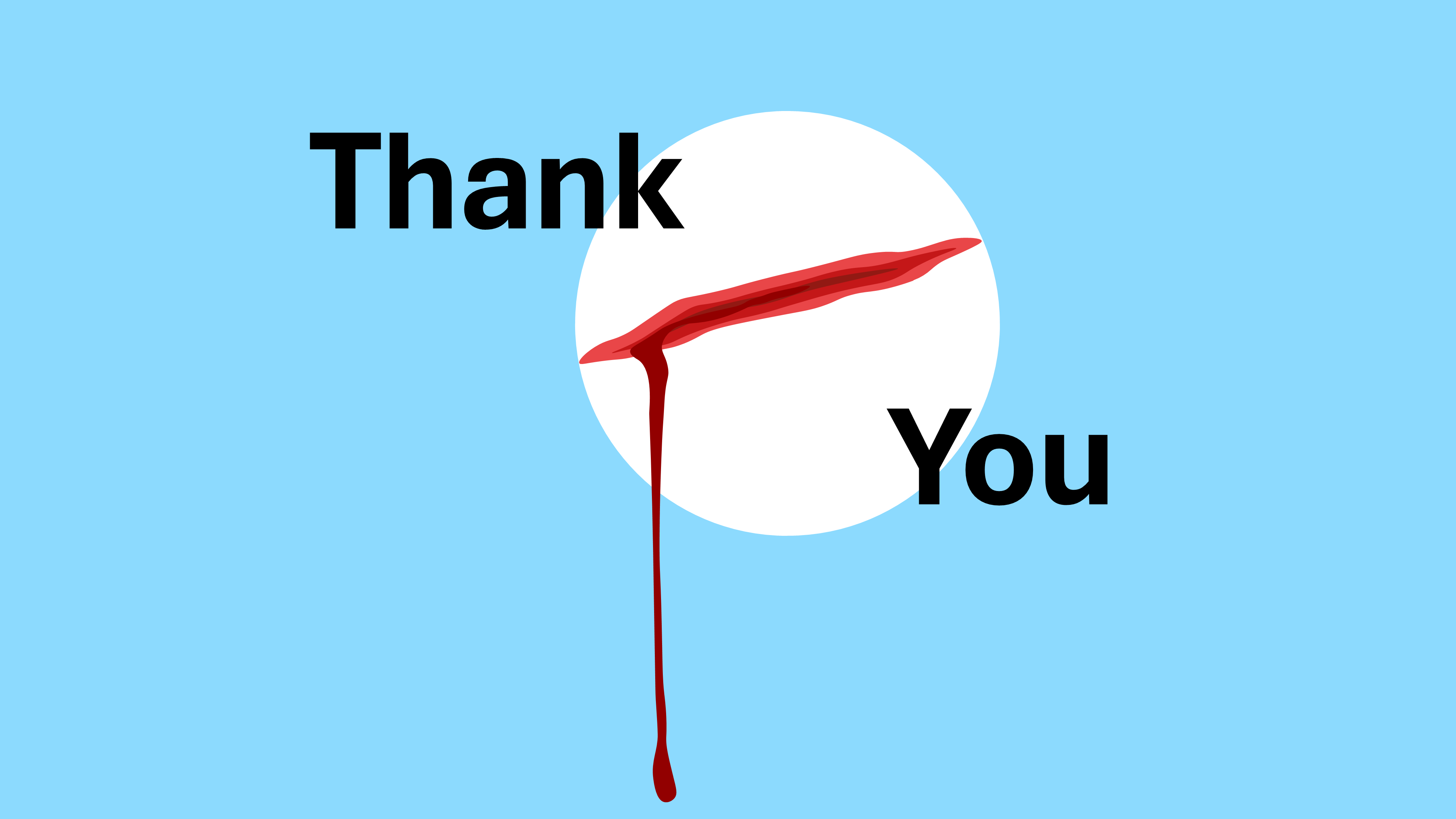
- This final slide is a powerful and memorable conclusion to the presentation. The words “Thank You” are split on either side of a simple, stylized image of a wound bleeding.
- This creative visual ties back to the central theme of wound management, leaving a lasting impression on the audience. It’s an impactful way to end the presentation, reinforcing the topic while expressing gratitude.
Features of
Wound Management Presentation
- Fully editable in PowerPoint
- All graphics are in vector format
- Medically Referenced information and data
Specifications
 Slides count:
Slides count: Compatible with:Microsoft PowerPoint
Compatible with:Microsoft PowerPoint File type:PPTX
File type:PPTX Dimensions:16:9
Dimensions:16:9
Elevate Your Work with Our Innovative Slides
Thank you! Your submission has been received!
Oops! Something went wrong while submitting the form.
No items found.



